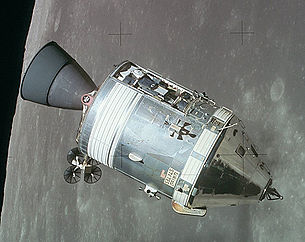Talk:Gravity
Add topicExercise
[edit source]
The Apollo Command Module
On July 20, Neil Armstrong and Buzz Aldrin became the first humans to land on the Moon. While Armstrong and Aldrin did important research on the surface of the moon, the third astronaut, Michael Collins orbited in the command module above. Determine the height (read: distance from the surface of the moon) at which Collins orbited in the command module by exploiting the following data. The moon has been approximated to weigh 7,3477×1022kg, and the radius to 1 737,10 km. The mass of the command module was 30,320 kg. Collins stayed in lunar orbit for 59 h 30 m. The command module did exactly 30 laps around the moon in this time. Assume that the orbit was circular and that the command module was very light compared to the moon.
The command module which stays in lunar orbit is constantly accelerating towards the moon, since a force acts on it. However, since the module has a large velocity component which is right to the gravitational force component (see schematic), it manages to overcome the acceleration towards the moon, so that the distance to the surface remains constant. It is then constantly falling without ever reaching the surface. Imagine throwing a rock. Eventually it will hit the ground since a gravitational force acts on it. But if you were to throw the rock fast enough the earth would "curve away" from the stone as it moves forward, and thus the rock would never hit the ground. The rock would then be in orbit.
Let be the command module's mass, and the moon's mass.
From Newton's Law of Universal Gravitation we get
Since the command module is in an orbit around the moon, we can also express the gravitational force which acts on the command module as
By substituting this into Newton's Law of universal Gravitation we get
By dividing the equation with we get.
By rewriting the centripetal acceleration we get
By solving the equation on we get
We can express the velocity of the command module in an other way. From the relation of velocity and angular velocity we get
And from the relation of orbital period and angular velocity we get
(The orbital period is equal to the time it takes for the Command Module to to one lap around the moon.) By combining both expressions and solving for we get
By substituting this expression into the expression we have from Newton's Law of Universal Gravitation we get
By solving for we get
Notice that the height at which the Command Module orbits the moon doesn't depend on the modules mass. As seen in the schematic, the value in the equation stands for the distance between the center of the moon and the center of the Command Module. We want to know the distance "" to the surface, which naturally is
Notice that we are making a small mistake by stating the above. We are actually calculating the distance from the center of the command module to the surface, not the distance from the side closest to the surface. This error is, however, so small that it makes no difference.
This gives
Inserting values gives


















![{\displaystyle r={\sqrt[{3}]{\frac {Gm_{2}T^{2}}{(2\pi )^{2}}}}}](https://wikimedia.org/api/rest_v1/media/math/render/svg/65aa73da47e5283062e2c702e748e1d89df98ed8)


![{\displaystyle h={\sqrt[{3}]{\frac {Gm_{2}T^{2}}{(2\pi )^{2}}}}-radius_{moon}}](https://wikimedia.org/api/rest_v1/media/math/render/svg/bb1e9b9e9fe9674e3739478bcc1780da600e2527)
![{\displaystyle h={\sqrt[{3}]{\frac {(6,67428\times 10^{-11}\ {\mbox{m}}^{3}\ {\mbox{kg}}^{-1}\ {\mbox{s}}^{-2})(7,3477\times 10^{22}kg)\mathbf {\left({\frac {59\cdot 60^{2}{\text{s}}+30\cdot 60{\text{s}}}{30}}\right)} ^{2}}{(2\pi )^{2}}}}-1737,10\times 10^{3}m}](https://wikimedia.org/api/rest_v1/media/math/render/svg/6bdc77d3e554b1c5d79101577467180bdff00f62)
